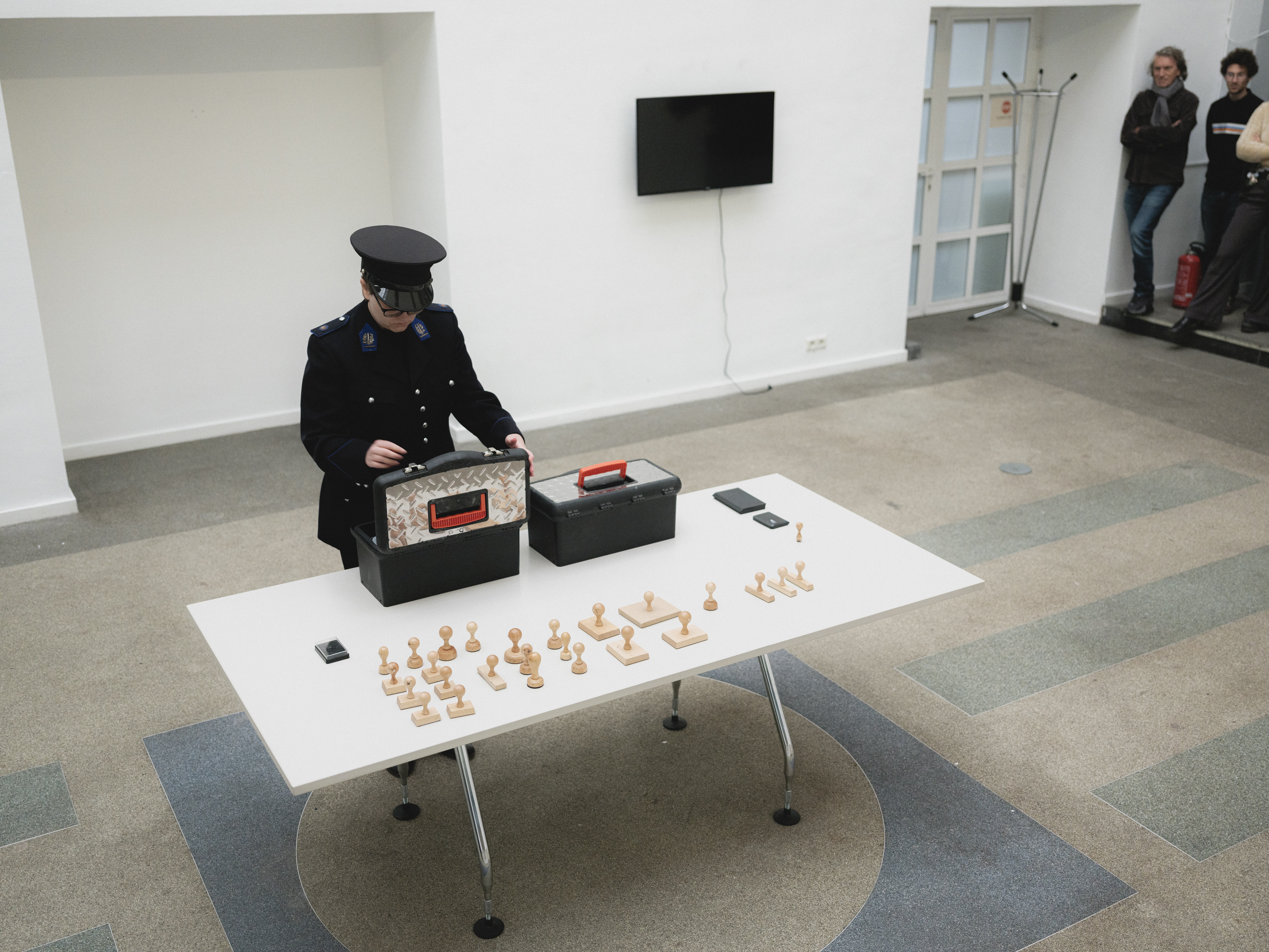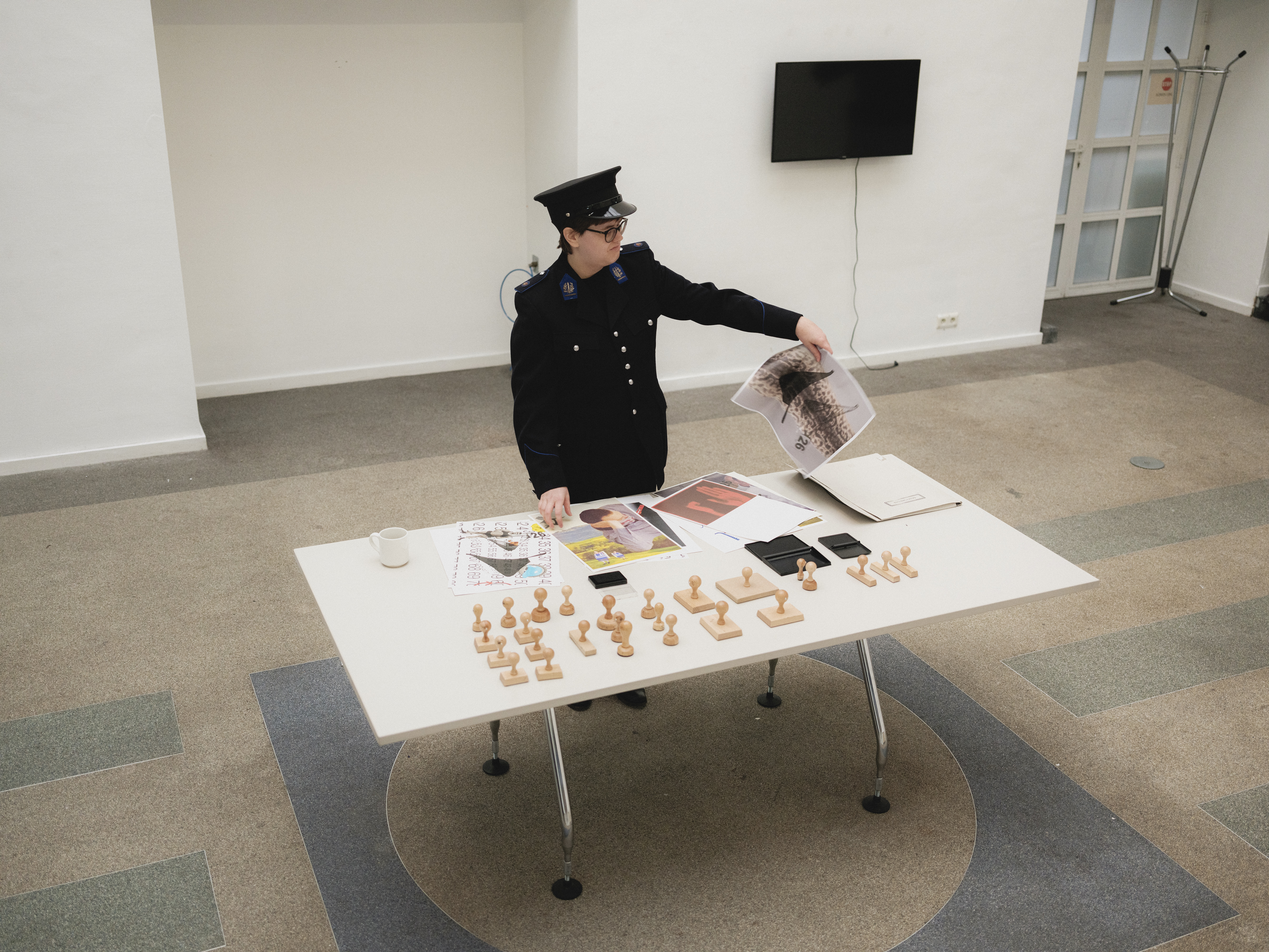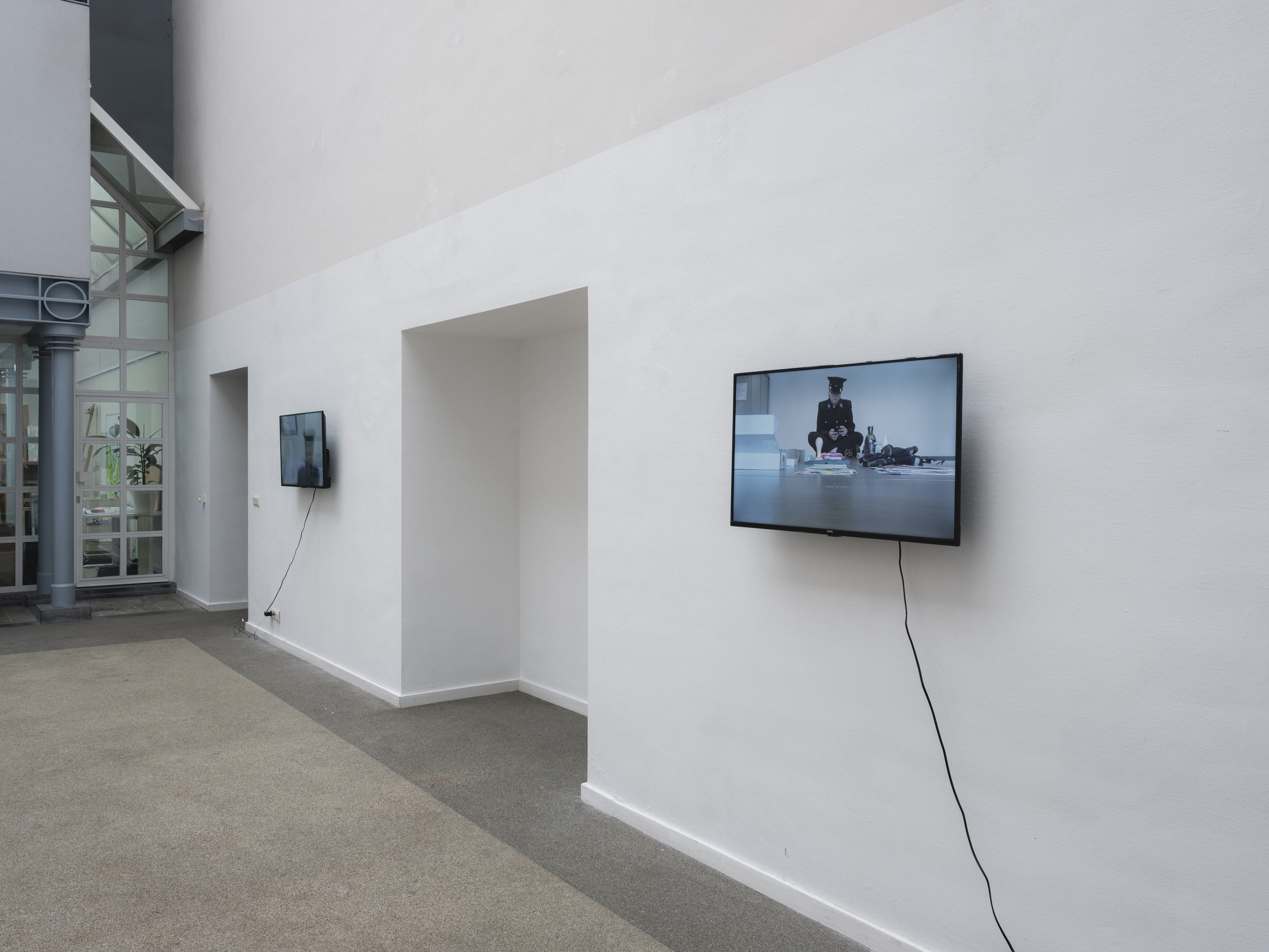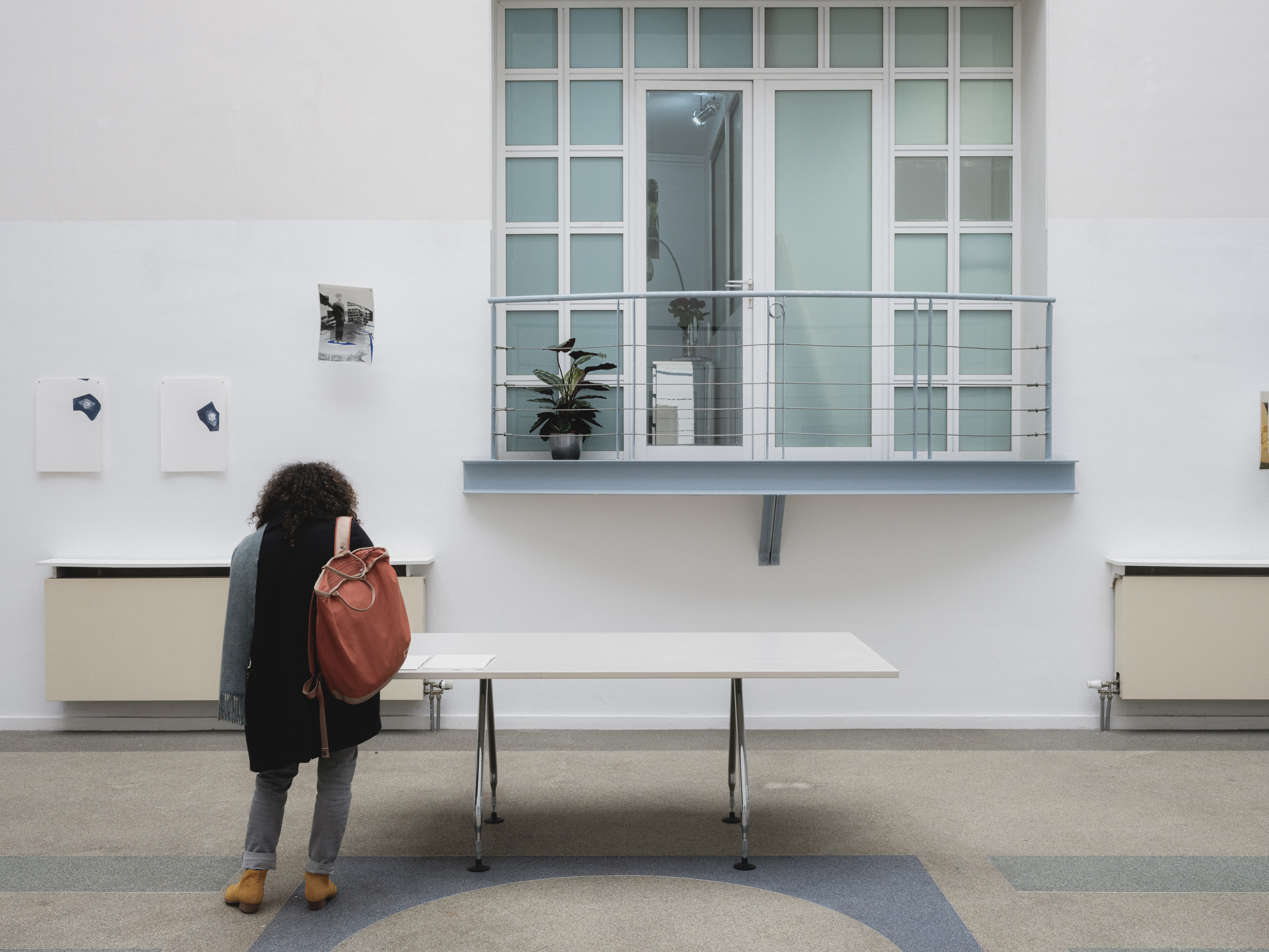Blue, 2024
Blue is het resultaat van een multidisciplinaire reflectie door Jivan van der Ende, die grafisch kunstenaar Elena Op 't Eynde heeft uitgenodigd om zich haar werk toe te eigenen door op te treden als politieagent, met als doel te spelen met de politieke dynamiek van macht of censuur, autoritaire apparaten en genderidentiteit in het patriarchaat in vraag te stellen.
Jivan van der Ende verlegt haar praktijk naar nieuwe media en nodigt ook anderen uit om deel te nemen, waardoor een reflectie op gang komt over het auteurschap van het kunstwerk en de onteigening ervan ten gunste van een op samenwerking en vertrouwen gebaseerde benadering. Voor 'Blue' probeert ze te spelen met auteurschap - vaak aangeduid als 'vaderschap' in een juridische context - door een nieuwe protagonist toe te voegen: De politieagent, geportretteerd door een collega grafisch kunstenaar. Deze twee figuren, belichaamd als één, voeden zich met elkaar om het redactionele werk van de kunstenaar te manipuleren. Dit gespeelde hybride archetype stelt vervolgens de grenzen van creatie en de regulering ervan ter discussie, evenals het geweld dat kan voortkomen uit de toe-eigening van het object en de gecorrigeerde intimiteit ervan. - SB34
Blue
19-20 oktober 2024
SB34 Clovis, Brussel
Een experimentele presentatie ter voorbereiding van een nieuw kunstenaarsboek van Jivan van der Ende, dat in 2025 uitkomt in samenwerking met Elena Op ‘t Eynde en P////AKT Amsterdam
Dank aan SB34:
Pauline Hatzigeorgiou, Rokko Miyoshi and Joséphine Wagnier
Fotografie: Adam Paluch
Video documentatie repetities: Jivan van der Ende
Performance docum
Medemogelijk gemaakt door de Vlaamse Gemeenschap, VGC Brussels, Nederlandse Ambassade in België
Medemogelijk gemaakt door @loterienationaleloterij, @federation_wallonie_bruxelles
















During the same weekend, SB34 organised its annual Open Studios. Here some pictures on my studio:









︎ Een dialoog tussen De Kunstenaar, De Politieman en De Commissaris
Joséphine Wagnier, Elena Op ‘t Eynde en Jivan van der Ende gaan in dialoog in het kader van de presentatie ‘Blauw’ tijdens de SB34 Clovis Open Studios. ‘Blauw’ is een nieuwe installatie en performance door Jivan van der Ende, ter voorbereiding van haar kunstenaarsboek dat verschijnt in 2025.
19 oktober 2024, Brussel
Jivan, hoe is het fictieve personage ’De Politieman’ ontstaan binnen je artistieke praktijk, dat gebaseerd is op drukwerk en installaties?
Jivan: ‘De Politieman’ kwam tot stand in het kader van mijn eerste solotentoonstelling ‘(ALL OF THE TIME)’ in 2020 bij LLS Paleis, in Antwerpen. Voor deze tentoonstelling creëerde ik een performance en installatie die zich elke 30 minuten herhaalde. De installatie bestond uit drukwerk, video’s, een tentoonstellingspublicatie en scènes die het geheel aan elkaar lijmde. Met de tentoonstelling wilde ik live in de ruimte werken met onderwerpen zoals machtsverhoudingen. Zo creëerde ik een fictief personage dat autoriteit zou hebben over mijn werk en de installatie. Dit personage oefende controle uit door middel van patrouilleren, het aan- en uitzetten van werken en het afdwingen van gehoorzaamheid. Met haar scènes manipuleerde ze de werken en liet ze het publiek getuige zijn van die manipulatie. Door het volgen van een reeks instructies, linkten de scènes van ‘De Politieman' de werken aan elkaar. De ultieme macht om te bepalen hoe de werken getoond zouden worden, lag bij het fictieve personage. Als kunstenaar ben ik geïnteresseerd in het loslaten van controle over mijn werk, te bevragen wat het betekent om een maker te zijn en te experimenteren met het maakproces. Via genderbending en speelse experimentatie ontwikkelde ik de absurde, autoritair-kritische en patriarchale rol van ‘De Politieman’ voor Elena Op ‘t Eynde, grafisch vormgever, uitgever en vriend.
Waarom was het belangrijk om ‘De Politieman’ terug te laten keren?
Jivan: Het deed zo’n deugd om haar comeback te orkestreren en voor mezelf een uitgewerkte kans te creëeren om rond machtsdynamieken te werken, specifiek diegene waar wij als queer vrouwen door onderdrukt en aan onderworpen worden. Het werkte bevrijdend om een simulatie van gewelddadige, patriarchale structuren op te zetten binnen de context van mijn eigen praktijk en om daarbij met een vertrouwde vriend te werken om samen deze structuren en de maatschappelijke instellingen die gewelddadige autoriteit, seksisme en queerfobie levend houden, artistiek te analyseren.
Een andere reden om het personage terug te brengen was om het idee van auteurschap en wat een kunstwerk eigenlijk is uit te dagen. Sinds 2020 werk ik aan een reeks drukwerken en ik wilde het concept van het uitgeven van deze serie verder ontwikkelen en uitdagen, door te experimenteren met het begrip van redigeren en uitgeven. Met de wens om samen met Elena een boek te maken, vielen alle puzzelstukken op hun plek om een publicatie (en daarmee ook een performatieve uitbreiding) van de reeks te ontwikkelen, waarbij zij in haar rol als ‘De Politieman' de publicatie zou vormgeven en redigeren. Onze manier van samenwerken interesseerde me ook sterk: er was ruimte voor een soort van intimiteit, zowel bij het maakproces als in de wijze waarop het werk getoond wordt aan het publiek. We zijn de laatste reeks aan het publiceren en we tonen hoe we daar geraakt zijn. We hebben dit personage ontwikkeld vanuit persoonlijke ervaringen met geweld, seksisme en autoriteit en dat resulteerde in een arbeidsintensieve en leuke genderbending exploratie naar de opbouw van een personage, haar scènes en haar manier van bewegen.
Elena, wat is jouw visie op samenwerken met kunstenaars en het kunstenaarsboek als medium?
Elena: Als grafisch ontwerper ben ik aangetrokken tot het samenwerken met kunstenaars. Het is interessant om mezelf onder te dompelen in andermans praktijk, om hun media en hun filosofie te onderzoeken en dit naar drukwerk te vertalen. Het is een ontzettend plezierige uitdaging om door middel van een kunstenaarsboek de kloof tussen vormgeving en beeldende kunsten te overbruggen. Ik neem graag mijn tijd om de praktijk van de kunstenaar te leren kennen, daarom geniet ik erg van langdurige samenwerkingen. Het is boeiend om hun werk te zien evolueren en het opent nieuwe mogelijkheden om dingen op papier tot uitdrukking te brengen. Het kunstenaarsboek is een goede partner van de kunstenaarspraktijk: het laat de kunstenaar toe een moment in hun praktijk vast te leggen en het samen te brengen in een compendium. Het kan makkelijk gedeeld worden, het kan door het publiek mee naar huis genomen worden en gearchiveerd worden voor latere reflectie. Dit is nog meer het geval bij performancekunstenaars. Het vluchtige aspect van beweging en hoe dat niet enkel op maar ook in het papier vertaald kan worden, fascineert me. Lezen kan zo’n tactiele en fysieke ervaring zijn. De laatste jaren werk ik meer en meer met performancekunstenaars: ik probeer kunstenaarsboeken te ontwerpen die de performance niet enkel reflecteren, maar er ook deel van gaan uitmaken. Het voelt passend dat ik nu zelf op een bepaalde manier deel ben geworden van de performance en daardoor nieuwe manieren vind om een publicatie vorm te geven. Elena, what is your perspective on collaborating with artists and the medium of the artist book?
Bij dit project ontwerp je niet als jezelf, maar als ‘De Politieman'. Heeft dit iets nieuws gebracht binnen je ontwerppraktijk?
Elena: Het was best uitdagend om na te denken hoe de publicatie vormgegeven zou worden terwijl ik deze rol op me nam. Ik heb echt het gevoel dat ik mezelf niet meer ben zodra ik in de rol van ‘De Politieman’ kruip en daarbij dus ook de grafisch ontwerper in mezelf achterlaat. Ik begon pas te zien hoe dingen samen vielen toen we begonnen met de repetities en ik weer het uniform aandeed, weer in zijn huid kroop. Tijdens de eerste performance in LLS Paleis in 2020, was het personage gewoon een jas die ik aantrok, veel nuance had hij nog niet. Tijdens de voorbereidingen van dit werk was het goed om veel over hem te praten, om hem zo meer context te kunnen geven en te begrijpen wat hij betekent voor de kunstenaar. Ik ontdekte dat veel van de hulpmiddelen die ‘De Politieman’ gebruikt – controle, autoriteit, censuur – ook hulpmiddelen zijn die op een manier in de ontwerppraktijk geïntegreerd worden. Wanneer een kunstenaar mij haar beelden en woorden toevertrouwt ben ik me heel bewust dat ik in essentie controle neem over hoe deze zaken gerepresenteerd en geïnterpreteerd zullen worden. Doorgaans benader ik dit heel voorzichtig en is dit een van de redenen waarom het gesprek met de kunstenaar zo belangrijk is in mijn ontwerpproces. Bij het aannemen van de rol ‘De Politieman’ kan ik mijn bewustzijn hiervan loslaten en kan ik me het materiaal van de kunstenaar volledig toe-eigenen, wat verrassend moeizaam is gebleken. Terwijl ‘De Politieman’ Jivan’s materiaal doorspit, blijft de kant van mezelf rondspoken die op zoek is naar een zorgvuldig geanalyseerde esthetische keuze.
Hoe wordt volgens jou de samenwerking tussen kunstenaar en grafisch ontwerper beïnvloed door het gebruik van een fictief autoritair figuur?
Elena: Het fictieve personage heeft een erg dominante aanwezigheid aangenomen in onze samenwerking, zoals we van hem konden verwachten. Het is een interessante ervaring geweest om de focus weg te nemen van de kunstenaar en de grafisch ontwerper en te spreken over een fictieve man die nu tussen ons in staat. We hebben veel tijd besteed aan hem beter te leren kennen en nu hij een duidelijkere vorm heeft aangenomen, is hij dominant aanwezig. Tijdens onze repetities stapte ik in en uit mijn rol en ontleedden we de acties van De Politieman ( / ontleedden we zijn acties). Dit gaf mij, als ontwerper, een beter begrip van zijn raison d’être en zo ook een beter begrip van de hulpmiddelen die hij gebruikt, die dan weer in het ontwerpproces vertaald kunnen worden. Jivan gaf commentaar op zijn onderdrukkende gedrag en de manier waarop hij zaken representeert waarmee zij worstelt. Omdat deze kennis aan mij werd doorgegeven, werd deze ook meteen doorgegeven aan De Politieman, die op zijn beurt al deze informatie in zijn volgende verschijning weer kon gebruiken tegen haar (werk). Op deze manier werd de rol van De Politieman verder uitgewerkt en werd het kader dat we bouwden rond zijn handelingen duidelijker. Het is dit arbeidsintensieve ontwerpproces dat me heeft toegelaten om mijn initiële ideeën voor het ontwerp van de publicatie los te laten, die vooral speelden met vrij stereotype vormen van censuur en onderdrukking. Door het aannemen van deze rol is de eigenlijke handeling van ontwerpen een organisch proces geworden, iets wat ik zelf bijna niet in de hand heb. Het zal interessant worden welk materiaal hieruit voortvloeit en hoe dit uiteindelijk uitmondt in een daadwerkelijke publicatie.
Joséphine, kan je wat meer vertellen over jouw praktijk als culturele producent en je visie op je curatoriële praktijk?
Joséphine: Eerst zou ik willen aangeven dat de connotatie van de term commissaire, het Franse woord voor curator dat ook gebruikt wordt om een hoofd politieagent aan te duiden, veelzeggend is voor wat er van ons verwacht wordt. Het is onze verantwoordelijkheid om toezicht te houden, om een vlotte gang van zaken en een goed beheer van een project of tentoonstelling te verzekeren. Ik heb lang geprobeerd mezelf te emanciperen van deze term, alsook van de term ‘curator’, wat letterlijk ‘zorgen voor’ betekent. In het Frans doet het ook denken aan het woord ‘curatelle’, dat verwijst naar de legale overname van administratieve en financiële zaken van een volwassenen. Het voelt bijna moederlijk aan, maar het is slechts een kleine verandering van een patriarchale figuur in vermomming (Het voelt bijna moederlijk aan, maar is eigenlijk slechts een patriarchale figuur in vermomming). Het idee van “zorg” en “zorg dragen”, is recentelijk - met goede bedoelingen - op de voorgrond komen te staan binnen hedendaagse kunst, maar in mijn opinie werd het concept nog niet ver genoeg verkend. Stellen dat zorg wordt geïmplementeerd, zonder het echt te bevragen of te beoefenen, brengt verschillende vormen van geweld voort. Het is ook erg moeilijk om jezelf als curator als “de enige verzorger” te beschouwen: de verzorger van de werken, van de kunstenaars en van het project. Daar is iets heel individualiserend en navelstarend aan. Er moet zeker iemand worden aangewezen die de taken coördineert die ondergeschikt zijn aan de creatie, maar de rol van verantwoordelijke mogen we niet geheel alleen opnemen. We moeten juist de curator, deze onbereikbare persoon, demystificeren – een curator is niets zonder alle andere individuen die het project mee begeleiden.
In dit geval, in deze context, vind ik het dubbelzinnig: ik ben niet de curator die dit project heeft aangesteld of heeft bedacht maar degene die het aandachtig begeleidt, zonder iets op te leggen. Dit is precies het tegenovergestelde van De Politieman, de derde creërende entiteit binnen het project. Het toont een verlangen van de kunstenaar om afstand te houden van de commissaire/curator als figuur, die een bepaalde dienst zou kunnen verlenen of eisen. Als ik de curator van het project was geweest, dan zou dit andere parameters of andere verwachtingen gegenereerd hebben. Ik vraag me af of De Politieman in staat zou zijn om tussen de twee makers van dit project in te komen staan. Zou hij in staat zijn om de keuzes van die derde figuur, die curator, te manipuleren? Zou hij tegen de commissaire in gaan?
Hoe verhoud jij je tot de curator als stereotiepe egocentrische figuur?
Joséphine: Enerzijds begrijp ik waarom dit beeld en deze figuur is ontstaan. Zoals ik eerder al vertelde is het een arbeidsintensieve job, wat niet altijd nadrukkelijk erkend wordt en we worden meer en meer gepusht om onszelf te bewijzen. De discipline heeft bepaalde individuen, in plaats van commissies of collectieven, opgehemeld als stercurators. Er is veel misbruik en er zijn grote ego's. Er wordt vaak misbruik gemaakt van de situatie. Gelukkig vinden we ook de mogelijkheid om binnen andere modellen te werken, om andere manieren om tentoonstellingen te maken: kunstenaars die andere kunstenaars uitnodigen bijvoorbeeld, waardoor het creatieve proces nieuwe wegen inslaat en opening vindt voor andere perspectieven, net zoals Jivan en Elena deden. Anderzijds is er een hele wereld die voortkomt uit de taal die we gebruiken, zoals wat er geïmpliceerd wordt door de term commissaire of curator, wat ik al eerder noemde. Voor mensen buiten de kunstwereld, of met weinig kennis van het vak, kan de term bij hen een bepaald idee van verantwoordelijkheid oproepen en respect afdwingen, refererend naar de gemachtigde/ een almachtige figuur die die wetgeving en handhaving belichaamt. Ik weet niet of dit ons naar het hoofd zou kunnen stijgen, ik heb ook nog geen curators in uniform gezien, ook al hebben we wel de neiging om gestandaardiseerde houdingen, fotoportretten en manieren van kijken aan te nemen. Een ding is voor mij zeker: de curator is meerdere figuren tegelijkertijd, omdat ze aan allerlei verschillende eisen moeten voldoen. Dit is ook afhankelijk van het instituut dat hen inhuurt en dat is ook waar de verschillende vermommingen van pas komen: de diplomaat, de toezichthouder, de logistiek manager, de afgevaardigde, etc.
Elena Op ‘t Eynde is een grafisch ontwerper, wonend in Brussel.
Joséphine Wagnier is een kunstwerker, deel van het SB34 team en woont in Brussel.
Dit interview werd vertaald naar het Nederlands door Madelon Dendooven
en naar het Engels en Frans door Joséphine Wagnier met Jack Cox als redigent.
Dit project is medemogelijk gemaakt door de Vlaamse Gemeenschap, de Nationale Loterij, Fédération Wallonie-Bruxelles, VGC Brussel en de Nederlandse Ambassade in België.
For the English translation of this interview: https://sb34.org/blue
Pour la traduction en anglais de cette interview (faites défiler la page vers le bas): https://sb34.org/blue
